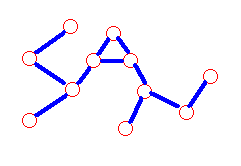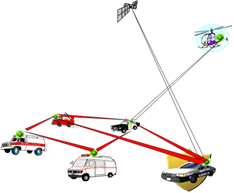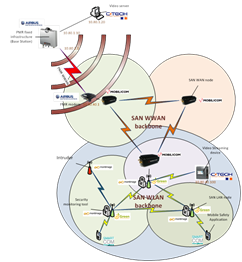SAN – Survivable Ad-Hoc Networks for 4G and beyond
 The SAN project aimed at developing a 4G broadband mobile wireless communication system endowed with a wide range of ad-hoc and relaying/mesh capabilities. SAN provided a solution based on rapidly deployable, self-configurable mobile wireless networks with no need for fixed infrastructures and external control or management systems. SAN developed a robust and cost-efficient solution for rescue teams and first responders’ organizations in a variety of scenarios when other communication networks are unavailable due to disaster, military actions, and other disruptions.
The SAN project aimed at developing a 4G broadband mobile wireless communication system endowed with a wide range of ad-hoc and relaying/mesh capabilities. SAN provided a solution based on rapidly deployable, self-configurable mobile wireless networks with no need for fixed infrastructures and external control or management systems. SAN developed a robust and cost-efficient solution for rescue teams and first responders’ organizations in a variety of scenarios when other communication networks are unavailable due to disaster, military actions, and other disruptions.
 Main focus
Main focus
Today, telecommunication infrastructures are usually not properly protected against unexpected events or crisis situations. During earthquakes, several base stations may collapse, the remaining network is overloaded, and the network seems to stop working. Therefore, it is essential to invest in R&D of solutions which enable people to communicate in such situations. The focus of SAN was on the development of survivable ad-hoc networks for 4G, which are based on the dynamic networking paradigms enabling people to communicate in a secure manner, even if the fixed network infrastructure does not work at all.
SAN aimed at resolving several fundamental shortcomings of modern wireless communication systems:
- The inability of direct communication between the equipment of different users, even when the link quality between them would allow transmission at high bit rates
- The need to guarantee system performance in complex radio planning
- The need to connect nodes and base stations in cumbersome fixed infrastructures, and thus the inability of rapid deployment required in many scenarios (disasters, military actions, etc.)
 Approach
Approach
The SAN project encompassed the whole LTE stack from bottom to top, leading to the integration of all these techniques in a demonstrator and the assessment of its performance:
- Methods and algorithms for radio interface control, e.g. dynamic frequency allocation without prior planning, interference mitigation, efficient link adaptation and spectrum utilization, etc.
- Medium Access Control (MAC) level mechanisms, e.g. ad-hoc mobile relay mechanisms, robust and energy efficient advertising of link topology, link layer self-* capabilities in dynamic environment.
- Network and upper layer techniques, e.g. real-time topology discovery with optimized overhead, robust mesh routing in dynamic topology, multicasting and broadcasting in dynamic environment.
- An integrated SAN prototype system, for demonstration and evaluation purposes.
Main results
The SAN project achieved the following main results:
- 2 new products prototypes
- 9 improved products
- 13 new recruited employees
- 9 prototypes and field trials
- 5 contributions to standards
- 9 deposited patents
About SAN
SAN is a Celtic-Plus project led by Airbus DS SLC which gathered the work of 12 partners from 6 countries:
- France: Airbus DS SLC, CEA, Green Communications, Montimage, UPE-MLV
- Israel : Runcom, Mobilicom
- Slovenia : Smartcom
- Spain : Indra, TTI Norte
- Turkey : C2Tech
- Russia : IITP
The project started on 1 November 2011 and ended on 31 October 2015. It received public funding from the Spanish Ministry of Industry, Tourism and Trade, the Ministry of Economic Development and Technology, the Turkish funding body Tubitak, the Ministry of Economy of Israel and the Direction Générale des Entreprises of France.
For further information, see the project website at: http://www.celtic-san.com/





